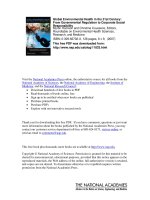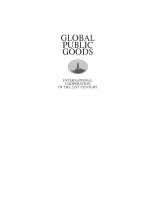Psychology applied to modern life adjustment in the 21st century, 11e chapter 10
Bạn đang xem bản rút gọn của tài liệu. Xem và tải ngay bản đầy đủ của tài liệu tại đây (1.02 MB, 58 trang )
Chapter 10
Marriage and Intimate Relationships
Challenges to the
Traditional Model of Marriage, continued
•
Marriage – “the legally and socially sanctioned union of sexually intimate
adults”.
•
Traditionally, it has also included
–
–
–
–
Economic interdependence.
Common residence.
Sexual fidelity.
Shared responsibility for children.
Challenges, continued
•
However, the following social trends have challenged the “traditional” model of
marriage:
1. Increased acceptance of singlehood – since the 1960s, the median age at
which people marry has been increasing (see Figure 10.1).
2. Increased acceptance of cohabitation – “living together in a sexually intimate
relationship without the legal bonds of marriage”.
Figure 10.1. Median age at first marriage. The median age at which people in the United States marry for the first time has been creeping up for both males and females since the
mid-1960s. This trend indicates that more people are postponing marriage. (Data from U.S. Bureau of the Census)
Challenges, continued
Trends, continued
3. Reduced premium on permanence.
4. Transitions in gender roles – role expectations are more varied, flexible, and
ambiguous.
5. Increased voluntary childlessness.
6. Decline of the “nuclear family”.
Deciding to Marry, continued
Cultural influences on marriages
•
•
80% of world cultures practice arranged marriages.
Priority is placed on the family’s, rather than the individual’s, welfare.
Deciding to Marry, continued
Selecting a mate
•
•
Monogamy - “the practice of having only one spouse at a time”.
Polygamy - involves “having more than one spouse at a time”.
–
–
Polygamy is practiced in many cultures.
It is most common where women have little or no independence, access to
education, or political power.
Deciding to Marry, continued
Selecting a mate, continued
•
•
Endogamy – “the tendency of people to marry within their own social group”.
Homogamy – “the tendency of people to marry others who have similar personal
characteristics”.
Deciding to Marry, continued
Selecting a mate, continued
•
Gender and mate selection preferences
–
Women place more value on a potential partner’s socioeconomic status,
intelligence, ambition, and financial prospects.
–
Men place more value on a potential partner’s youthfulness and physical
attractiveness.
Deciding to Marry, continued
Predictors of marital success
–
Family background – people whose parents were divorced are more likely to
divorce themselves.
–
–
Age – those who marry at a younger age are more likely to divorce.
Length of courtship – longer periods of courtship are associated with marital
success.
–
Personality – perfectionism and insecurity are loosely associated with marital
problems.
Deciding to Marry, continued
Predictors of marital success, continued
–
Personality – perfectionism and insecurity are loosely associated with marital
problems.
–
Premarital interaction – quality of premarital communication is especially
crucial.
•
In particular, negativity, sarcasm, insulting remarks and being
unsupportive are all associated with marital distress.
Marital Adjustments, continued
•
The family life cycle – “is an orderly sequence of developmental stages that
families tend to progress through”.
•
McGoldrick’s (1988, 1999) model outlines the special challenges that are faced by
couples as they progress through six stages of family life (see Figure 10.4).
Figure 10.4 Stages of the family life cycle. The family life cycle can be divided into six stages, as shown here (based on Carter & McGoldrick, 1988). The family’s key developmental
task during each stage is identified in the second column. The third column lists additional developmental tasks at each stage.
Marital Adjustments, continued
McGoldrick’s model, continued
1. Between families: the unattached young adult
• As people postpone marriage, this stage will likely lengthen.
2. Joining together: the newly married couple
• This “honeymoon” phase is characterized by high levels of satisfaction.
Marital Adjustments, continued
McGoldrick’s model, continued
3. Family with young children
• Birth of the first child brings a major transition and potential stress, especially
for mothers.
•
The key to reducing stress during this transition is having realistic
expectations.
Marital Adjustments, continued
McGoldrick’s model, continued
4. Family with adolescent children
• Adolescence is rated as the most difficult stage of parenting, and marital
satisfaction is at its lowest point.
•
Conflict is especially likely between teens (both males and females) and
mothers.
•
In addition, many couples are also caring for their own aging parents. These
double responsibilities spurred the term, the “sandwich generation”.
Marital Adjustments, continued
McGoldrick’s model, continued
5. Launching children into the adult world.
• Also called the “empty nest” phase, it was traditionally thought to create
feelings of loss.
•
However, women’s roles extend beyond parenthood, and this is now generally
associated with greater marital satisfaction.
•
Problems usually only occur when adult children return to “the nest”.
Marital Adjustments, continued
McGoldrick’s model, continued
6. The family in later life
• Marital satisfaction tends to climb in the postparental period when couples
have more time to devote to one another.
•
This continues until a spouse’s health begins to decline and/or a spouse dies.
Vulnerable Areas, continued
1.
Gaps in role expectations
–
There are now new expectations about marital roles, and women are
especially affected.
•
•
More women now have demanding careers.
Yet, they are often interrupted to have children or to follow their
husbands.
–
In addition, wives still do 65% of the household chores, even when
they work similar hours (see Figure 10.5).
Figure 10.5 Division of household labor. This chart breaks down the proportion of housework done by husbands and wives for specific tasks. The data show that wives continue to do
a highly disproportionate share of most household tasks, especially the “core housework” tasks (cooking, cleaning, laundry) that are hard to ignore. Note also, that in spite of great
changes in modern life, the division of labor in the household still largely meshes with traditional gender roles. (Data from Bianchi et al., 2000)
Vulnerable Areas, continued
2. Work and career issues
– Work and marital adjustment
•
•
Husbands and wives struggle to balance the demands of work and family.
However, benefits of multiple roles to both spouses include
–
–
–
Social support.
Increased income.
Having more in common.
Vulnerable Areas, continued
2. Work and career issues, continued
– Parents’ work and children’s development.
•
•
Parents often worry about the impact of their dual careers on the children.
However, there is actually little evidence that a mother’s working is
harmful to her children, especially after the child is one year of age.
Vulnerable Areas, continued
3. Financial difficulties
– Serious financial worries tend to cause
•
•
•
–
Increased hostility in husbands.
Increased depression in wives.
Lower marital happiness in both spouses.
In addition, risk of separation and divorce increases as husband’s income
declines.
–
Arguments over how to spend money are common and potentially damaging
at all income levels.
Vulnerable Areas, continued
4. Inadequate communication
– Communication problems are the most frequently cited problem among couples
getting a divorce (see Figure 10.6).
–
In addition, unhappy couples
•
•
•
•
•
Find it difficult to convey positive messages.
Misunderstand each other more often.
Don’t recognize they’ve been misunderstood.
Use more negative messages.
Prefer different amounts of self-disclosure.
Figure 10.6 Causes of divorce. When Cleek and Pearson (1985) asked divorcing couples about their perceptions regarding the causes of their divorce, both men and women cited
communication difficulties more than any other cause.









